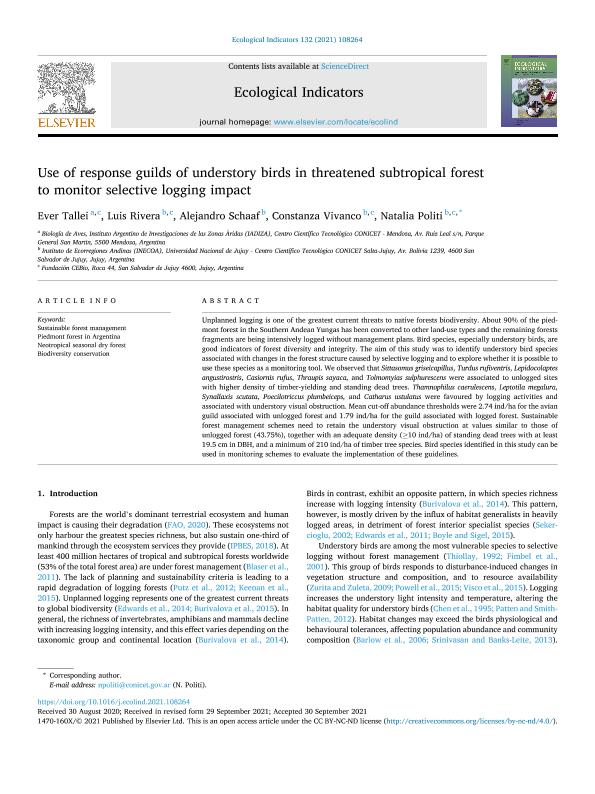Mostrar el registro sencillo del ítem
dc.contributor.author
Tallei, Ever Denis

dc.contributor.author
Rivera, Luis Osvaldo

dc.contributor.author
Schaaf, Alejandro Alberto

dc.contributor.author
Vivanco, Constanza Guadalupe

dc.contributor.author
Politi, Natalia

dc.date.available
2022-09-20T15:37:21Z
dc.date.issued
2021-12
dc.identifier.citation
Tallei, Ever Denis; Rivera, Luis Osvaldo; Schaaf, Alejandro Alberto; Vivanco, Constanza Guadalupe; Politi, Natalia; Use of response guilds of understory birds in threatened subtropical forest to monitor selective logging impact; Elsevier Science; Ecological Indicators; 132; 12-2021; 1-10
dc.identifier.issn
1470-160X
dc.identifier.uri
http://hdl.handle.net/11336/169604
dc.description.abstract
Unplanned logging is one of the greatest current threats to native forests biodiversity. About 90% of the piedmont forest in the Southern Andean Yungas has been converted to other land-use types and the remaining forests fragments are being intensively logged without management plans. Bird species, especially understory birds, are good indicators of forest diversity and integrity. The aim of this study was to identify understory bird species associated with changes in the forest structure caused by selective logging and to explore whether it is possible to use these species as a monitoring tool. We observed that Sittasomus griseicapillus, Turdus rufiventris, Lepidocolaptes angustirostris, Casiornis rufus, Thraupis sayaca, and Tolmomyias sulphurescens were associated to unlogged sites with higher density of timber-yielding and standing dead trees. Thamnophilus caerulescens, Leptotila megalura, Synallaxis scutata, Poecilotriccus plumbeiceps, and Catharus ustulatus were favoured by logging activities and associated with understory visual obstruction. Mean cut-off abundance thresholds were 2.74 ind/ha for the avian guild associated with unlogged forest and 1.79 ind/ha for the guild associated with logged forest. Sustainable forest management schemes need to retain the understory visual obstruction at values similar to those of unlogged forest (43.75%), together with an adequate density (≥10 ind/ha) of standing dead trees with at least 19.5 cm in DBH, and a minimum of 210 ind/ha of timber tree species. Bird species identified in this study can be used in monitoring schemes to evaluate the implementation of these guidelines.
dc.format
application/pdf
dc.language.iso
eng
dc.publisher
Elsevier Science

dc.rights
info:eu-repo/semantics/openAccess
dc.rights.uri
https://creativecommons.org/licenses/by/2.5/ar/
dc.subject
BIODIVERSITY CONSERVATION
dc.subject
NEOTROPICAL SEASONAL DRY FOREST
dc.subject
PIEDMONT FOREST IN ARGENTINA
dc.subject
SUSTAINABLE FOREST MANAGEMENT
dc.subject.classification
Conservación de la Biodiversidad

dc.subject.classification
Ciencias Biológicas

dc.subject.classification
CIENCIAS NATURALES Y EXACTAS

dc.title
Use of response guilds of understory birds in threatened subtropical forest to monitor selective logging impact
dc.type
info:eu-repo/semantics/article
dc.type
info:ar-repo/semantics/artículo
dc.type
info:eu-repo/semantics/publishedVersion
dc.date.updated
2022-09-05T14:05:12Z
dc.journal.volume
132
dc.journal.pagination
1-10
dc.journal.pais
Países Bajos

dc.journal.ciudad
Amsterdam
dc.description.fil
Fil: Tallei, Ever Denis. Consejo Nacional de Investigaciones Científicas y Técnicas. Centro Científico Tecnológico Conicet - Mendoza. Instituto Argentino de Investigaciones de las Zonas Áridas. Provincia de Mendoza. Instituto Argentino de Investigaciones de las Zonas Áridas. Universidad Nacional de Cuyo. Instituto Argentino de Investigaciones de las Zonas Áridas; Argentina
dc.description.fil
Fil: Rivera, Luis Osvaldo. Universidad Nacional de Jujuy. Instituto de Ecorregiones Andinas. Consejo Nacional de Investigaciones Científicas y Técnicas. Centro Científico Tecnológico Conicet - Salta. Instituto de Ecorregiones Andinas; Argentina
dc.description.fil
Fil: Schaaf, Alejandro Alberto. Universidad Nacional de Jujuy. Instituto de Ecorregiones Andinas. Consejo Nacional de Investigaciones Científicas y Técnicas. Centro Científico Tecnológico Conicet - Salta. Instituto de Ecorregiones Andinas; Argentina
dc.description.fil
Fil: Vivanco, Constanza Guadalupe. Universidad Nacional de Jujuy. Instituto de Ecorregiones Andinas. Consejo Nacional de Investigaciones Científicas y Técnicas. Centro Científico Tecnológico Conicet - Salta. Instituto de Ecorregiones Andinas; Argentina
dc.description.fil
Fil: Politi, Natalia. Universidad Nacional de Jujuy. Instituto de Ecorregiones Andinas. Consejo Nacional de Investigaciones Científicas y Técnicas. Centro Científico Tecnológico Conicet - Salta. Instituto de Ecorregiones Andinas; Argentina
dc.journal.title
Ecological Indicators

dc.relation.alternativeid
info:eu-repo/semantics/altIdentifier/url/https://www.sciencedirect.com/science/article/pii/S1470160X21009298
dc.relation.alternativeid
info:eu-repo/semantics/altIdentifier/doi/http://dx.doi.org/10.1016/j.ecolind.2021.108264
Archivos asociados
